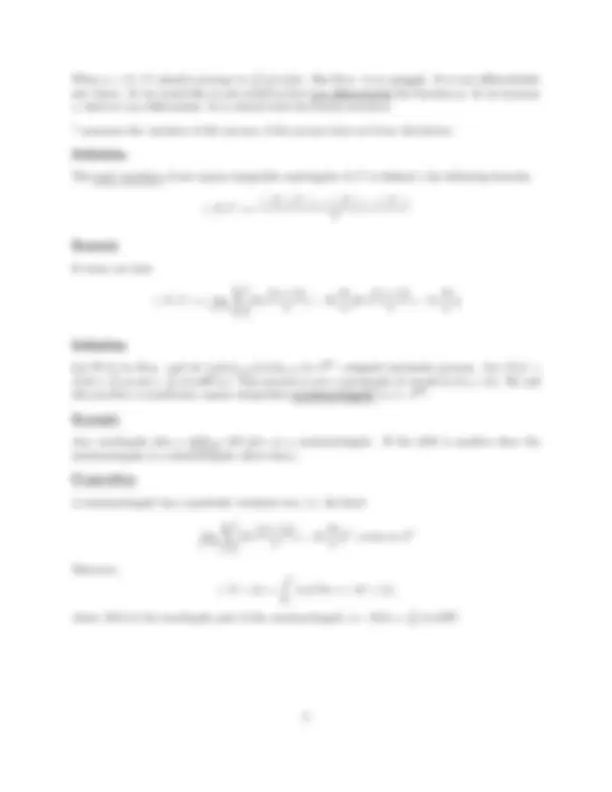



Study with the several resources on Docsity

Earn points by helping other students or get them with a premium plan


Prepare for your exams
Study with the several resources on Docsity

Earn points to download
Earn points by helping other students or get them with a premium plan
Community
Ask the community for help and clear up your study doubts
Discover the best universities in your country according to Docsity users
Free resources
Download our free guides on studying techniques, anxiety management strategies, and thesis advice from Docsity tutors
Class: TOPICS IN PROBABILITY THEORY AND STOCHASTIC PROCESSES; Subject: Mathematics; University: Kent State University;
Typology: Study notes
1 / 3

This page cannot be seen from the preview
Don't miss anything!


Properties of the stochastic integral:
aX(s) + bY (s)dW (s) = a
∫ (^) t
0
X(s)dW (s) + b
∫ (^) t
0
Y (s)dW (s)
∫ (^) t 0 X(s)dW^ (s)] = 0
∫ (^) t 0 X(s)dW^ (s)
(^2) ] = ∫^ t 0 E[Y^ (s)
(^2) ]ds
∫ (^) t 0 g(s)dW^ (s). Then^ Y^ is adapted to^ FW^.
If It =
∫ (^) t 0 g(s)dW^ (s), then^ I^ is a^ F
W (^) -martingale.
Examples: Models that describe the dynamic behavior of asset prices contain invention terms that represent unpredictable news. As a result, an integral of the form ∫ (^) t+∆t
t
σ(s)dW (s)
is a sum of unpredictable disturbances that affect asset prices during an interval of length ∆t. Now, if each increment is unpredictable given the information set at time t, the sum of these increments should also be unpredictable. This means that
∫ (^) t+∆t
t
σ(s)dW (s)|Ft) = 0
But this is equivalent to:
∫ (^) t+∆t
0
σ(s)dW (s)|Ft) = E(
∫ (^) t
0
σ(s)dW (s)|Ft) =
∫ (^) t
0
σ(s)dW (s)
which is exactly the martingale property of the stochastic integral. Hence, the existence of unpre- dictable innovation terms in equations describing the dynamics of asset prices coincides well with the martingale property of the Ito integral. Let’s look at particular case: σ(s) = σ, a constant. Then: (^) ∫ (^) t+∆t
t
σ(s)dW (s) = σ(Wt+∆t − Wt)
Exercises:
∫ (^) t
0
E(X(s)Y (s))ds
where I(X) is the si of X with respect to W. 2) Verify the equality: ∫ (^) t
0
W (s)dW (s) =
2 W^ (t)
2 t
using the definition of the stochastic integral.
Quadratic variation of a martingale:
Theorem:
Let M be a martingale such that for any t ≥ 0, E[(Mt)^2 ] < ∞ (i.e. square integrable martingale).Then the quantity n∑− 1
k=
(k + 1)t n )^ −^ M^ (^
kt n )]
2
converges in L^2 to a r.v. A(t) that is called quadratic variation of M, and it is denoted by A(t) =< M > (t).
Properties:
A is a stochastic process that is adapted to FM^ , i.e. A(t) ∈ FtM.
A(t) is non-decreasing a.s.
Remark:
For B.m. we have
E[
n∑− 1
k=
(k + 1)t n )^ −^ B(^
kt n )]
n∑− 1
k=
E[[B( (k^ + 1)t n
) − B( kt n
n∑− 1
k=
t n
= t
Exercise: Show that < B > (t) = t, < W > (t) = t, if B is a B.m.
Remark:
The converse is also true (Paul Levy): If M is a square integral martingale that is a.s. continuous, and if < M > (t) = t, then M is a B.m.
Interpretation:
What is the interpretation of quadratic variation?
n∑− 1
k=
|f ( t(k^ n+ 1) ) − f ( tkn )|1+α^ →? as n → ∞
For B.m. (∗) → ∞ if α < 1 ; (∗) → t if α = 1 : (∗) → 0 if α > 1